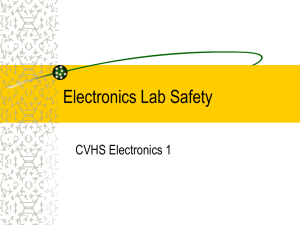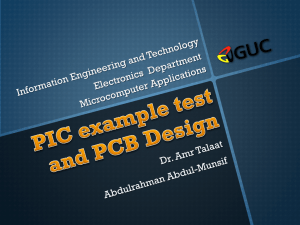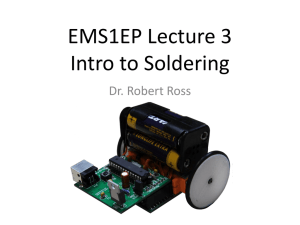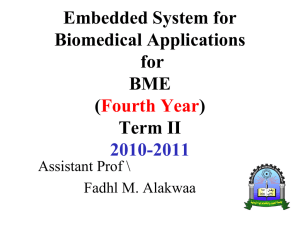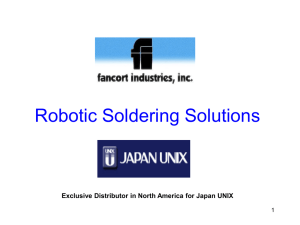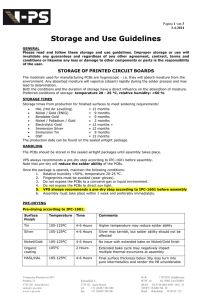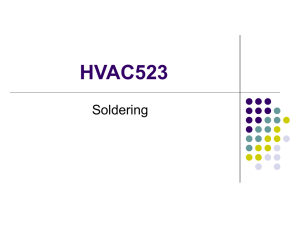Robotic Soldering Systems
advertisement
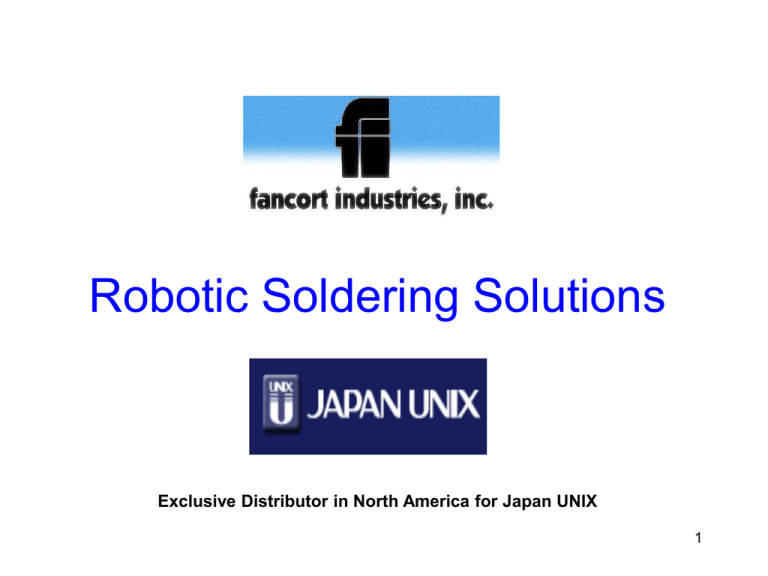
Robotic Soldering Solutions Exclusive Distributor in North America for Japan UNIX 1 Solutions Offered: • Contact Soldering-most common • Ultrasonic Soldering • Non-contact Soldering: • Laser Soldering • Microflame Soldering Each has it’s place and price point! 2 Contact Soldering Opportunities: What to look for - Many operators doing difficult hand soldering with high labor costs -Soldering quality problems, throughput too low or inconsistent results -An existing robotic system that may need replacing-wearing out, poor results, lack of factory support -Selective soldering that can’t be easily done with typical bottom side selective soldering systems -Post wave or reflow hand soldering that is better done with a robot 3 UNIX Contact System A very robust platform using the Janome four axis robot 4 Multi-Articulated Six Axis Robot #700V • Works like a human arm and hand • Much larger working area than a desktop • Ideal for in-line automation • 5300mm/sec max. velocity 5 700V Multi-Articulated Soldering Robot 6 Cartesian Robot #700S • 5-Axis • Suitable for in-line automation • 1130mm/sec max. velocity 7 SCARA Robot #700H • 5 Axis • Increased reach for large working area • 7128mm/sec max. velocity • Three models with max. reach radius of 350, 450 and 550mm 8 Point to Point Example of wires soldered to ceramic substrate 9 Slide Soldering Post Reflow of Connector 10 Point to Point on LCD 11 Medical Device Co. Small wires on substrate 12 LED Through-Hole Post Reflow 13 Two Wires Soldered to Small Piezoelectric Battery 14 Automotive, Two Areas, Point to Point 15 Contract Manufacturer with Medical Application •Twenty up fixture to solder two wires from a battery to pads on a flex circuit •Used a UNIX414R desktop with N2 16 Defense Company Six-up fixture to hold components for soldering four wires into their PCB 17 Fixture with Heater Plate Project required preheating this multi-layer PCB in order to solder some ceramic components. Insulator is underneath the heater plate to protect the robot 18 Complex Fixture for OEM •Four step soldering process with four subassemblies •Rotating member to solder both sides of the PCB •Order was won from less expensive competitor because of fixture design 19 Laser Soldering 20 Laser Soldering Opportunities • -Extremely small points of soldering without the need for contact • -Intense heat required • -Short cycle time required • -No residue after soldering • -Some industries that require this are medical device manufacturing, or look for applications like fine pitch soldering for micro joining wires, large pad automotive soldering 21 Laser Diode Soldering Background Information • UNIX is a leader in Japan in laser soldering systems with many more installations than Apollo Seiko. • MTA is also a competitor but tends to build more in-line systems • UNIX builds their own laser; Apollo is a reseller of another manufacturers laser system • Applications are growing for laser systemsmedical device manufacturing is a hot area 22 Laser System w/Enclosure 23 24 In-Line Laser System 25 Interior of In-Line Laser 26 UNIX Ultrasonic Soldering • • • • Primary applications are soldering on glass which is used in the solar cell manufacturing industry, soldering on copper, aluminum or other metal surfaces that conventional soldering is not as effective The principle behind ultrasonic soldering is high-frequency ultrasonic vibrations that promote removal of the dirt on the base material, or reducing oxide films, diffusing metals, removing air bubbles, etc. This leads to improvement in wettability and spreadability of the solder producing better joints and reducing tack time UNIX is ahead of the competition in this technology and can do sampling in Japan. The technology is available in a manual station (next slide) and integrated to a robotic system. • No need for flux 27 Ultrasonic Soldering • Controller Hand Held Iron 28 Microflame Soldering: Opportunities -More heat is required to make a connection than conventional contact soldering can achieve -Extremely small point of contact; flames can be much smaller than the smallest soldering iron tip -Very fast cycle time; typically 1-2 seconds per solder joint -Applications can be found in the industrial market as well as electronic manufacturers -Fancort is an authorized Spirflame integrator, a leader in microflame technology 29 Fancort Delivered $85K Custom Spirflame System for Soldering Cord Sets • Processes 260 cord sets per hour 30 Cord Sets with different gauge wires were done on the same machine The application required more heat than contact soldering could provide 31 Manual Microflame System • • • • • Stand-alone system with generator, flame, solder feeder and controller Flame is driven in Z motion by cylinder; solder feeder must be accurately positioned; operator uses a fixture to hold the work and steps on the foot switch, flame comes down, feeder feeds wire to programmed amount, and soldering is done very quickly. Ideal for development work or manual soldering where microflame fits the application Cost is approximately $25K Easy to use and very safe 32 Microflame or Contact? Application was to solder two reed switches into this coil with minimal stress to protect glass seals-Decided on contact soldering w/UNIX Arrows to point of contact 33 31 Fairfield Place West Caldwell, NJ 07006 Ph. 973-575-0610 Fx. 973-575-9234 www.fancort.com UNIX CONTACT SOLDERING “FAB” SHEET Features Advantages Benefits 1. Soldering head can do point-to-point and line soldering 2. Solid core solder tips retain heat from point to point 3. Scale and tooling pins to accurately realign solder head and feeder 4. Program up to 63 soldering conditions 5. Standard 200W heater with built-in thermocouple; optional 300W 6. Unit section of heater block easily removed to speed up tip and heater replacement times 7. Graduated angle setter is standard 8. Easy to program soldering profiles on teach pendant 9. Several alarms standard including out of solder, solder jamming and heater alarm 10. Three axis tip position correction mechanism. 11. Solder wire preheater to reduce heat shocking that results in solder balls 12. Needle swing mechanism allows solder feeder needle to swing away from tip automatically 13. Solder tips have 500 microns of iron plating versus competition with 250-300 14. Optional nitrogen generator 1.1 No need to purchase two different soldering heads 2.1 Faster cycle time 3.1 Changeover from line soldering to point to point is easy and accurate 4.1 Reduces the need to create separate programs for different conditions on one assembly 5.1 Heats up and recovers faster than 100W heaters 1.1 Save money and save time with simple changeover 2.1 Lower costs of operation per assembly 3.1 Save time in setups and eliminate costly errors 4.1 Increased throughput 5.1 More throughput 6.1 Save time 6.1 Save money 7.1 Solder feed position is perfectly reproduced each time you return to a setup 8.1 Only one device needed for all programming 9.1 Prevents mistakes and saves time 7.1 Saves time; improves consistency 10.1 Automatically corrects misalignment after replacing tip 11.1 Maintains consistent solder quality 10.1 Save money in eliminating missed solder joints 1.1 Reduce rework; save money 12.1 Allows clearance for easier tip cleaning, access to tight areas and easier to program 12.1 Save time, avoid solder errors 13.1 Longer life of tips; less changeover time lost 13.1 14.1 Prevents oxidation of tips and produces better flow or wetting 14.1 Higher quality and less maintenance 8.1 Simplicity! 9.1Save money in reduced rework Save money 34 Thank You • For further information, or to discuss a specific application, contact Deborah Tinfow at 973-5750610x238 or by email at: dtinfow@fancort.com • Please visit our website for other videos and more technical information; www.fancort.com 35
